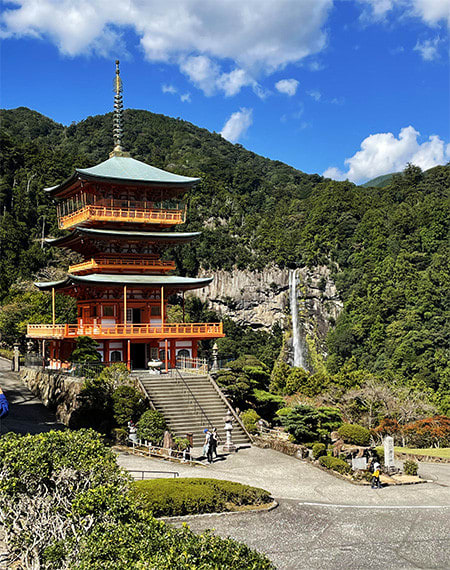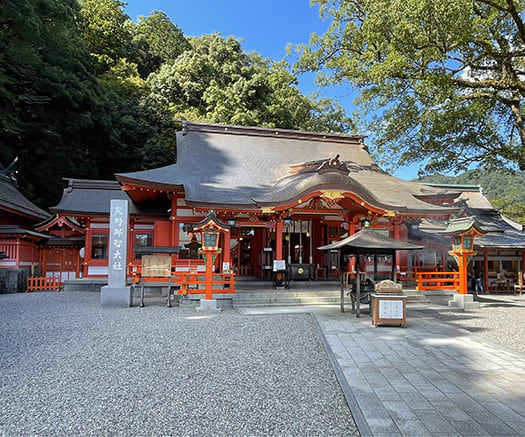



熊野那智大社の社域には隣接して「青岸渡寺」という天台の寺院がある。
それほど予備知識なく訪問したわたしは「え、なにこれ、神社なのに仏塔がある?」としばし唖然としておりました。調べてみると「那智山」は熊野三山の一つで熊野信仰の霊場として長い歴史がある。もともと那智の滝を中心にした神仏習合の一大修験道場だったが、明治初期に青岸渡寺と那智大社に分離した。今も寺と神社は隣接していて、双方を参拝する人が多い、のだという。
もともとが修験道の聖地という歴史があるとされている。この青岸渡寺の由緒書きを見ると以下。
〜開基は仁徳帝の頃(4世紀)、印度天竺の僧「裸形」上人が那智大滝において修行を積みその暁に瀧壷で八寸の観音菩薩を感得し、ここに草庵を営んで安置したのが最初。 その200年後、推古天皇の頃、大和の「生佛」上人が来山し、前述の話を聞き一丈(3m)の如意輪観世音を彫み、裸形上人が感得した八寸の観音菩薩を胸佛に納め勅願所として正式に本堂が建立された〜
裸形とか、生佛(どう考えても「いきぼとけ」か)とかの露骨な人名表現。どうも仏教の本筋というよりもやや飛躍した、いかにも修験道的な風合いがそこに感じられるように思う。
そういう修験的な寺院として、日本的な鷹揚さをもった神社信仰が徐々に「習合」していったような経緯を感じさせてくれる。

修験道は断食、瞑想、経典の唱え、滝の下での祈りなどの禁欲的な修行などを指す。7世紀の伝説の神秘家であり術師でもある役行者または役小角(634–700年)が起源と言われるけれど、日本的な常識的ビジュアルとしてはやはり「瀧に打たれる」という様子がイメージされる。
三千六百峯とされる熊野の豊かな自然環境の代表スポットとしてこの那智の滝が表徴化されたのか。そういった修験道スポットに対して敬意を表して神社が勧請され、さらに日本独特な宗教の垣根取り払い運動があって、神仏習合という概念が進んで行ったのではないだろうか。
やはり多様な国土環境の中での精神風土として「純粋性」よりも「和を尊ぶ」傾向がより優勢になるのが日本の特徴であるように思う。一神教と多神教の社会の違いとも思える。世界の中でこういった日本人はやはり特異な精神性を持っていると言えるのだろうか。
その後、戦国期になってキリスト教・一神教が浸透してきたけれど、やはり多数派としては多神教的社会の保持に傾いていったのには、この熊野那智大社と青岸渡寺のような宗教ジャパネスク、習合思想が底流としてあるのだと思える。
やはり神社信仰は宗教というよりは習俗・慣習の面の方が大きい。列島人の基本心性がそのことを表現しているのだろう。それが熊野という特殊な日本的地域信仰形成につながった。
English version⬇
The Shinto/Buddhist syncretism of religious Japanesque Myths of the Imperial Family and the Kumano Journey - 25
Japanese society does not "fit in" with monotheistic exclusion of others. The "let bygones be bygones" sentiment prevails over the fundamentalism that leads to dictatorship. ...
Adjacent to Kumano Nachi Taisha is a Tendai temple called Seigantoji.
I visited the temple without much prior knowledge and was stunned to see a pagoda in the midst of a shrine. I was stunned. Nachi is one of the three mountains of Kumano and has a long history as a sacred place of Kumano worship. Originally, it was a major training center for the practice of Shintoism and Buddhism, centering on Nachi Falls, but it was separated into Seigando-ji Temple and Nachi Taisha Shrine in the early Meiji period (1868-1912). The temple and shrine are still adjacent to each other, and many people visit both.
It is said that the temple has a history of originally being a sacred place for Shugendo. The history of Seigando-ji is as follows
〜The temple was founded in the 4th century during the reign of Emperor Nintoku (4th century) by a priest named Nigakata Shonin from India, who ascended to the Nachi Great Falls and, upon ascending, saw the eight-sided bodhisattva Kannon in the waterfall basin. Two hundred years later, during the reign of Emperor Suiko, a "Seibutsu" priest from Yamato came to the temple, heard the above-mentioned story, and carved a one-length (3 m) Nyoirin Kannon.
The use of explicit personal names such as "nakagata" and "ikibutsuke" ("living Buddha" or "ikibotoke"). I feel that the temple has an atmosphere of Shugendo, which is a leap forward rather than the main line of Buddhism.
It seems to me that the Japanese-style worship of shrines was gradually "merged" with this kind of Shugendo-like temple.
Shugendo refers to ascetic practices such as fasting, meditation, chanting sutras, and praying under waterfalls, and is said to have originated with the legendary 7th century mystic and practitioner En no Gyoja or En no Shokaku (634-700), but the common Japanese visual image is still "being hit by a waterfall. The image of a waterfall is also commonplace in Japan.
Nachi Falls may have been symbolized as a representative spot of the rich natural environment of Kumano, which is said to have 3,600 peaks. Shrines were built to pay homage to such spots of Shugendo, and the concept of Shintoism-Buddhism syncretism may have developed as a result of the movement to remove religious boundaries unique to Japan.
I believe that the tendency to "respect harmony" rather than "purity" is a characteristic of Japan's spiritual climate in the midst of its diverse land environment. This can be seen as the difference between a monotheistic and a polytheistic society. Can it be said that the Japanese people have a unique spirituality in the world?
Later, during the Warring States period, Christianity and monotheism penetrated Japan, but the majority tended to maintain a polytheistic society, which I believe is based on the religious Japanesque and syncretistic philosophy of Kumano Nachi Taisha and Aogishitoji Temple.
After all, shrine worship is more of a custom and practice than a religion. The basic mentality of the people of the archipelago expresses this. This is what led to the formation of Kumano, a unique Japanese regional belief.



















